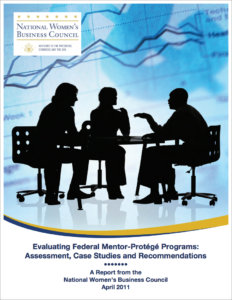 Evaluating Federal Mentor-Protégé Programs: Assessment, Case Studies, and Recommendations
Evaluating Federal Mentor-Protégé Programs: Assessment, Case Studies, and Recommendations
National Women’s Business Council
First published April 2011
Mentor-Protégé Programs exist in many federal agencies to help small businesses gain technical and business skills from large prime contractors and to build networks and experience that will help them compete and succeed in the federal contracting landscape. Started by the Department of Defense in 1991, there are now many versions of Mentor-Protégé Programs that share similar objectives but have different programmatic and incentive structures. The National Women’s Business Council conducted a research initiative to learn how well Mentor-Protégé Programs are serving women-owned businesses and how they might be strengthened to help women-owned businesses become an even greater engine driving economic recovery.
NWBC’s study focused on Mentor-Protégé Programs in six agencies: the Department of Defense, Department of Energy, Department of Homeland Security, Health and Human Services, National Aeronautics and Space Agency, and the Small Business Administration. The project involved extensive literature research, a questionnaire sent to 130 women-owned business protégés, and follow-up interviews with protégé CEOs and Agency program staff.
Data indicate that women-owned businesses represent 30% of all protégé companies participating in Mentor-Protégé Programs in the six agencies examined for this study. Most protégé companies are finding the programs beneficial but there is considerable room for improvement. Programs would be enhanced by creating more consistency in the incentive structure of Mentor-Protégé Programs across the federal landscape, providing increased training and accountability for mentors, helping protégé firms to negotiate stronger agreements, improving data collection, and increasing outreach to women-owned businesses. Efforts to make MentorProtégé Programs more effective and consistent will help to strengthen the women-owned business sector, create greater equity in the distribution of federal contracting dollars, and improve the performance of women-owned businesses in government contracting.
Download Resource